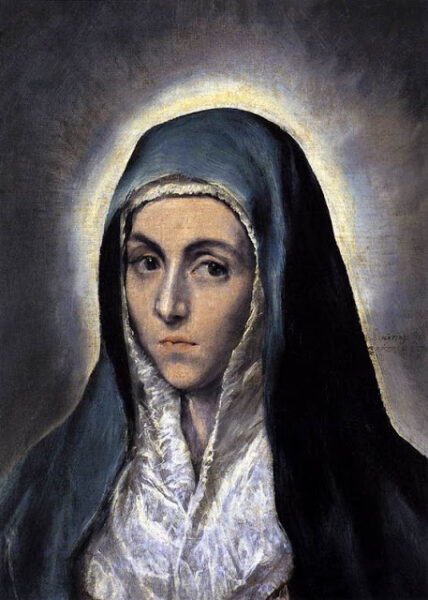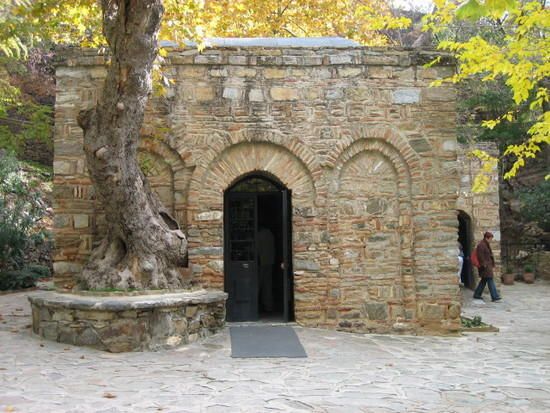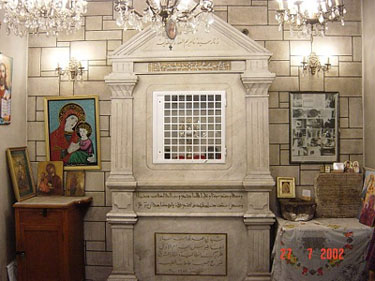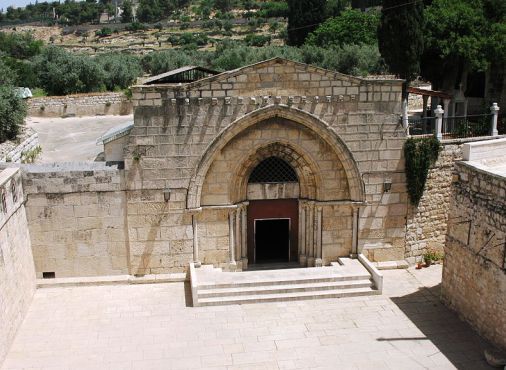Assumption Day Greece Dekapenteavgoustos 15 August

Virgin Mary El Greco
15 August, Assumption Day, Dormition of the Blessed Virgin Mary, Dormition of the Most Holy Mother of God, in Greek: “Dekapentavgoustos” and “Koimmisis Tis Theotokou”, is the third most important religious celebration in Greece, after Easter and Christmas, it commemorates the death of Mary, the mother of Jesus.
The death of The Virgin Mary
Mary spent her final days living peacefully in Ephesus (Modern day Turkey), tended to by the apostles, who accompanied her on frequent trips to Jerusalem.

The House of the Virgin Mary, Ephesus, Turkey
After her death, Mary was laid to rest near the Garden of Gethsemane, Apostle Thomas, who was away travelling in India at the time of her death, immediately returned to Jerusalem to pay his respects.
On entering Mary’s tomb, Thomas discovered her body had disappeared and the tomb was now filled with fragrant flowers, traditionally said to be roses and lilies.
On looking upwards, Thomas had a vision of Mary ascending to heaven, at that moment Mary untied her sash, which fell at the feet of Thomas.
Parts of the sash, today a Holy relic, are housed in the Prato Cathedral, Tuscany, Italy and Saint Mary’s Church of the Holy Belt, Homs, Syria.

Saint Mary’s Church of the Holy Belt – Homs, Syria. Photo Stalinsunnkvj
The apostles assumed that God had retrieved the body of Mary and reunited it with her soul in heaven, from this derives the name Assumption Day.
There are two places in Jerusalem today, associated with the death of The Virgin Mary, the Basilica in the Garden of Gethsemane, the site of her tomb, and the Abbey of Dormition, built on the site where Mary is said to have died.

Tomb of The Virgin Mary, Garden of Gethsemane, Jerusalem, Israel
15 August Assumption Day – Greek celebrations
Preparations for this important date in The Greek Orthodox Church begin on the first of August with strict fasting, lasting until the Feast Day of The Virgin Mary on the fifteenth.
The fifteenth of August is a public holiday in Greece, as it is in most catholic countries of Europe and Latin America.
Mary is one of the most popular Name Days as Mary; (Maria) is the most common female name in Greece. Despina, Thespina, Marios, Panayiota, and Panayiotis (Peter) are also celebrated.
-e1666442490810.jpg)
The Assumption of the Virgin, Peter Paul Rubens (c. 1612-17)
The whole of Greece celebrates, friends and relatives, laden down with beribboned boxes of delicious cakes, descend on the “Name Day Girl” (Or boy), who will have been slaving away over her cooker since early morning, preparing mouthwatering Greek dishes for her visitors.
After church, towns and villages lay on huge communal feasts accompanied by traditional dancing, fueled by gallons of local wine.
Local 15 August celebrations in Greece
Most towns and villages have their own fifteenth of August traditions, below are some of the more well-know, popular celebrations, legends and traditions:
The Island of Tinos
Devout Christians make the pilgrimage to the church of Panagia Evangelistria, on the Greek island of Tinos, situated near the port, crawling all the way to the church, along a red carpet, laid for this special occasion.
You can see why this place is sometimes referred to as “The little Lourdes of Greece”!

Church of Panagia Evangelistria, Tinos
Legend has it that here, a nun, Saint Pelagia, had a vision of The Virgin Mary, informing her of where to find an icon which possessed healing powers, and was ordered to search for the icon in the Ant. Doxaras area.
An icon depicting The Virgin Mary was eventually found underground in 1823 in the Kechrovouni region.
Icon of the annunciation of the Virgin Mary – Panagia Evangelistria church, Tinos
Imathia, Kastania, Central Macedonia
The Miraculous Journey of the Wandering Icon of the Holy Virgin Atheniotissa
According to legend, two monks from Athens, Barnabus and Sofronios, had a vision, in which the Virgin Mary, told them to leave Athens and head for Trebizond (Modern day Trabzon, Turkey), where they were to build a monastery.
For protection during their hazardous journey, they were to carry with them the icon of the Holy Virgin Atheniotissa, said to have been painted by Saint Luke, which was housed in the Church of Panagia Athiniotissa, in Athens.

Icon of The Holy Virgin Atheniotissa Attributed to Saint Luke Now in the Monastery of Our Lady of Soumela, Kastania, IImathia
In the year 386, on Mount Melas, the famous Monastery of Our Lady of Soumela, was built, making it the home of the icon of the Holy Virgin Atheniotissa.

Monastery of Our Lady of Soumela, Trebizond (Trabzon, Modern day Turkey)
After the collapse of the Ottoman Empire, in 1923, the monastery was abandoned after the monks of Sumela Monastery were forced to flee following the genocide of Greeks in Asia Minor.
Before fleeing, the monks had managed to save certain items from the monastery, including the icon of Panagia Soumela, which they buried a short distance from the monastery.
In 1931 Greece received permission to excavate the area and the treasures were eventually unearthed.
They were all returned to Athens and remained at the Benaki Museum in Athens for 20 years.
In 1951, Greek refugees from Trebizond, built the new Panagia Soumela Monastery, on the slopes of Mount Vermion, near the town of Naousa.

Panagia Soumela Monastery – Built 1951 – Mount Vermion – Greece
In 1952, on the 15th of August, the miraculous icon was brought from the Benaki Museum and placed in the new Monastery of Soumela.
Even though the new home of the icon is called the Monastery of Soumela, there are no monks or nuns who live in this remote mountain site.
Thousands flock to the feast day of The Virgin Mary, on the fifteenth of August, to pray before the miraculous Atheniotissa icon.
The Island of Paros
Another church celebrating on the fifteenth of August is the Church of the Hundred Doors, located on the island of Paros, dedicated to “Panagia Ekatontapilion”, meaning “The Virgin of the Hundred Doors”.
 Paros, Greece.jpg)
Our Lady of the Hundred Doors – Paros
Icon of Our Lady of the Hundred Doors – “Panagia Ekatontapilion” – Paros
Ninety nine doors are visible, the story goes, that the hundredth door, will be revealed when Greece again occupies Constantantinople (Istanbul ).
The Island of Kefalonia
In the village of Markopolou, on the island of Kefalonia, is the church of The Virgin Mary Lagouvarda, or “Panagia Fithousa”, Virgin of the Snakes”

Church of the Virgin Mary Lagouvarda – Virgin of the Snakes – Markopoulou – Kefalonia
Here, from the sixth to the fifteenth of August, harmless snakes gather in and around the church.
On the fifteenth the snakes head for the icon of The Virgin Mary and the Bishop’s throne.

Snakes on the icon of Virgin Mary, Virgin of the Snakes, Kefalonia
The island was attacked by Barbarossa in 1705, it is said the nuns begged The Virgin Mary, to help them escape, who then turned them into snakes, and they slithered away to safety.
Kozani Northern Greece
On the morning of fifteenth august, riders, on decorated horses, meet at Sitista to accompany the faithful to the Monastery of The Virgin Mary in Mikrokastro, Kozani where they pay their respects to the icon of The Virgin Mary.

Monastery of the Virgin Mary, Mikrokastro
On the return journey, a stop is made at church of the Prophet Elija, and there, in the church grounds, they hold a small celebration, with food, drink and dancing, at lunch time they return to Siatista, where, in the evening thousands gather in the squares of Hora and Gerania to see the magnificent horses on parade.

Horsemen of Mikrokastro
This tradition stems from when Greek slaves, of Western Macedonia, under Ottoman rule, were granted one day of freedom to celebrate the fifteenth of August, when, on horseback, they would return to their families for celebrations and to give thanks at the Church of The Virgin Mary.
Related links:
Saints and Celebrations of the Greek Orthodox Church



